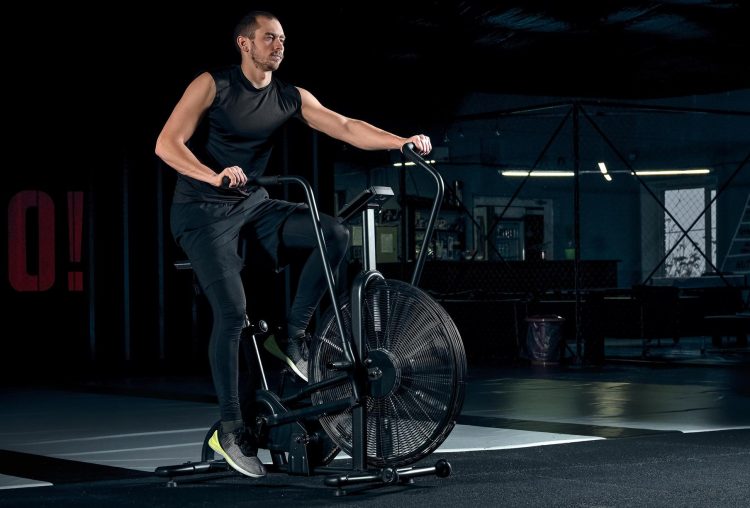Diet and exercise are the two main drivers of effective fat loss. Although you can shed weight by cutting calories, working out can fast-track your weight loss and help you achieve the physique of your dreams.
This is supported by a comprehensive meta-analysis published in the International Journal of Obesity, which found that individuals who combine diet with regular exercise experience better long-term results than those who focus on diet alone. (1)
However, one thing I’ve seen over my coaching career is that people tend to focus on the wrong exercises when trying to lose fat. I hate to break it to you, but no number of crunches will burn down that stubborn belly fat.
A well-structured workout split, on the other hand, will.
12-Week Workout Split For Fat Loss
The following workout split is one of the best approaches to losing stubborn body fat, especially if you aren’t physically active. It is one of my personal favorites, and it offers several benefits, including:
Level Up Your Fitness: Join our 💪 strong community in Fitness Volt Newsletter. Get daily inspiration, expert-backed workouts, nutrition tips, the latest in strength sports, and the support you need to reach your goals. Subscribe for free!
- Maximizes fat loss by increasing weekly calorie expenditure by combining full-body strength training, HIIT, and steady-state cardio.
- It gets more challenging over the weeks as you grow stronger, fitter, and more accustomed to the routine.
- Offers full-body engagement, enhances muscle growth, and accelerates weight and fat loss.
- Prioritizes rest to allow for adequate physical and mental recovery to mitigate injury and avoid the risk of overtraining.
As you can see, this is a very well-balanced approach that promotes sustainable fat loss and boosts your overall strength and endurance.
Weeks 1-4
Here’s what the first month of this split would look like.
- Monday: Full-Body Strength Training
- Tuesday: Cardio
- Wednesday: Full-Body Strength Training
- Thursday: Rest
- Friday: Full-Body Strength Training
- Saturday: Cardio
- Sunday: Rest
The first four weeks of the program revolve around improving overall fitness levels. The main focus is to get stronger and burn as many calories as possible without overworking the body.
You shouldn’t (and probably can’t) start with a very demanding training split, as that is how you get overly tired and discouraged before you see any actual results. So, we start slowly and progress steadily.
Strength Training
Weight training will help you shed weight and burn fat. It will help you become stronger and leaner. You will also build new muscle tissue, which will not only result in better body aesthetics but will also help you burn more calories throughout the day, as muscle mass is more metabolically active than fat mass. (2)
For the first four weeks of your fat-loss journey, you should do something like:
| Exercise | Weight, Sets, and Reps |
| Bench Press | 60% of 1RM, 3 sets, 8-10 reps |
| Squats | 60% of 1RM, 3 sets, 8-10 reps |
| Assisted Pull-Ups | 3 sets, 8-10 reps |
| Deadlifts | 60% of 1RM, 3 sets, 8-10 reps |
| Assisted Dips | 3 sets, 8-10 reps |
| Weighted Lunges | 3 sets, 8-10 reps |
As you can see, the focus here is on compound movements that activate your entire body. There are no isolation exercises yet, as I generally introduce those after a month once the client gets accustomed to training.
Treat the first week as your baseline. Having a clear baseline is vital if you wish to progress during these four weeks. Write everything down. Write how many sets and reps you did, and jot down the weight you moved so you can do more next week.
The goal for the first month is to increase your reps, not weight, as research indicates that the progress is comparable whether you focus on increasing one or the other. (3)
So, simply add one repetition to each set, as that’s about 10% in this particular rep range and aligns with the progressive overload principles.
Cardio Training
I like to include 15 minutes of after-training steady-state cardio, such as running and cycling, to wind down after a resistance training session.
However, over the years, I have found that a dedicated HIIT cardio training session is much more beneficial for weight loss than just doing cardio at the end of a regular resistance training session. The main reason for this is that fatigue accumulates during the workout, and we’re not left with enough cardiovascular endurance to push hard enough at the end of the session.
That said, I suggest you do the following cardio workout twice a week for the first four weeks:
| Exercise | Rounds and Working Time | Rest |
| Assault Bike | 5 rounds, 20 seconds | 10 seconds |
| Box Step-Ups | 5 rounds, 20 seconds | 10 seconds |
| Bodyweight Sumo Squats | 4 rounds, 30 seconds | 30 seconds |
| Burpees | 4 rounds, 30 seconds | 30 seconds |
| Bodyweight Lunges | 4 rounds, 30 seconds | 30 seconds |
According to scientific data, HIIT cardio training (or cardio training, in general) burns more calories than resistance training and is a much better way to achieve weight loss. (4)
However, the difference in caloric expenditure between the two is negligible in the early stages because, as I said previously, many people do not yet have the cardiovascular endurance to push long and hard enough. That said, performing these sessions will ensure you build cardiovascular endurance rather quickly.
As a result, over time, you’ll be able to perform more advanced routines and get much higher calorie expenditure.
Weeks 5-12
After a month, you will probably be several pounds lighter and in much better shape due to a neat thing called “newbie gains.” Because of this, you should adjust your training regimen.
The following eight weeks of your training should look something like this:
- Monday: Upper Body
- Tuesday: Lower Body
- Wednesday: Rest
- Thursday: Upper Body
- Friday: Lower Body
- Saturday: Rest
- Sunday: Rest
You should progress to an upper-lower split for the remainder of this 12-week fat loss journey.
Level Up Your Fitness: Join our 💪 strong community in Fitness Volt Newsletter. Get daily inspiration, expert-backed workouts, nutrition tips, the latest in strength sports, and the support you need to reach your goals. Subscribe for free!
An upper-lower split introduces new exercises to the mix and allows you to target more areas and muscle groups than a full-body split. In addition, it allows for 72 hours of rest between similar sessions, meaning you can start your training fully rested and perform to the best of your abilities.
Here’s what a full week of training will look like during weeks 5-12:
Upper Body (Monday)
| Exercise | Weight, Sets, and Reps |
| Bench Press | 70% of 1RM, 4 sets, 8-10 reps |
| Bent-Over Rows | 70% of 1RM, 4 sets, 8-10 reps |
| Assisted Pull-Ups | 4 sets, 8-10 reps |
| Bicep Curls | 70% of 1RM, 4 sets, 8-10 reps |
| Tricep Rope Pushdown | 70% of 1RM, 4 sets, 8-10 reps |
| Lateral Raises | 70% of 1RM, 4 sets, 8-10 reps |
Lower Body (Tuesday)
| Exercise | Weight, Sets, and Reps |
| Squats | 70% of 1RM, 4 sets, 8-10 reps |
| Leg Press | 70% of 1RM, 4 sets, 8-10 reps |
| Leg Extensions | 70% of 1RM, 4 sets, 8-10 reps |
| Standing Calf Raises | 70% of 1RM, 4 sets, 8-10 reps |
| Hip Thrust | 70% of 1RM, 4 sets, 8-10 reps |
| Cable Crunches | 70% of 1RM, 4 sets, 8-10 reps |
Upper Body (Thursday)
| Exercise | Weight, Sets, and Reps |
| Incline Dumbbell Press | 70% of 1RM, 4 sets, 8-10 reps |
| Seated Rows | 70% of 1RM, 4 sets, 8-10 reps |
| Lat Pulldowns | 70% of 1RM, 4 sets, 8-10 reps |
| Skull Crushers | 70% of 1RM, 4 sets, 8-10 reps |
| Overhead Press | 70% of 1RM, 4 sets, 8-10 reps |
| Face Pulls | 70% of 1RM, 4 sets, 8-10 reps |
Lower Body (Friday)
| Exercise | Weight, Sets, and Reps |
| Deadlifts | 70% of 1RM, 4 sets, 8-10 reps |
| Hamstring Curls | 70% of 1RM, 4 sets, 8-10 reps |
| Romanian Deadlifts | 70% of 1RM, 4 sets, 8-10 reps |
| Seated Calf Raises | 70% of 1RM, 4 sets, 8-10 reps |
| Hip Thrust | 70% of 1RM, 4 sets, 8-10 reps |
| Cable Crunches | 70% of 1RM, 4 sets, 8-10 reps |
As you can see, the variety of exercises is much greater here. Still, another notable difference is that you are now lifting heavier weights compared to the first four weeks. You go back to the 8-10 rep range but will be lifting heavier weights.
You will repeat this same process two more times.
Cardio Training
As you saw above, your weekly split did not include dedicated cardio sessions. However, that doesn’t mean there aren’t any. In fact, there are more.
For the remainder of the 12-week program, you will do the following HIIT training session at home on alternate days:
| Exercise | Rounds and Working Time | Rest |
| Squats | 4 rounds, 40 seconds | 20 seconds |
| Burpees | 4 rounds, 40 seconds | 20 seconds |
| Jumping Jacks | 4 rounds, 40 seconds | 20 seconds |
| Push-Ups | 4 rounds, 40 seconds | 20 seconds |
Progression, in this case, will be very simple.
With each passing week, you will add one round to two exercises of your choice. Then, on the twelfth week, you will add one round to all four exercises, raising the total duration of your at-home HIIT session to 32 minutes.
Now, depending on your weight and the intensity at which you’re performing these exercises, that twelfth-week HIIT session could burn around 400 calories.
What Other Exercises Can You Add To Your Fat-Loss Workout Split?
In addition to a structured workout split I just discussed, you can do a few other exercises and activities to improve fat loss. These include:
Running
Running is arguably the best activity for weight loss. It is an excellent cardiovascular exercise that engages numerous muscle groups while burning a lot of calories.
The issue for untrained people is that it is nearly impossible to start running for 30, 45, or 60 minutes without prior training, making it hard to rely on running as an effective fat-burning method.
However, if muscular and cardiovascular endurance isn’t an issue for you, and you’re an experienced exerciser, running at 6 mph for an hour could burn up to 900 calories, depending on your weight.
Swimming
Swimming is another incredible full-body workout that can be exceptional for weight loss. It burns a considerable amount of calories and engages nearly every muscle in your body.
Even better, swimming is a low-impact exercise that usually doesn’t take a big toll on your body, so going swimming on your rest day could be a great idea to burn off some extra calories for the day.
As for calorie expenditure during swimming, there are just too many factors to say precisely, but you could burn anywhere from 300 to 600 calories in an hour.
Cycling
Cycling is probably the easiest form of exercise you can do if you’re looking to lose weight, whether you’re riding a stationary bike or a regular one.
A good thing about cycling (and every other activity on this list) is that you can easily adjust your pace and intensity. You can cycle for an hour at a light pace or switch up and sprint for a few minutes every so often.
Now, depending on the intensity and body weight, you can expect to burn between 300 and 600 calories in an hour.
Is Exercise Alone Enough For Fat Loss?
Unfortunately, not even a well-structured workout program can overcome the effects of a bad diet, as the fundamental principle of weight loss (and with it, fat loss) revolves around calories in versus calories out.
You have to eat in a caloric deficit to lose fat. Any additional calories you burn through exercise are just a bonus. It’s that simple. But just in case it isn’t, let’s paint a picture.
A 30-minute HIIT workout we just went through could burn around 400 calories, and an hour of resistance training could burn 200-300. However, a single Big Mac you can eat in minutes is more than 550 calories. So, you can see how relying on exercise to “burn off” what you just ate might not work.
So, while exercise does burn calories and can contribute to the overall caloric deficit, it is more than likely not enough. Even if it were, it would be much easier to create a caloric deficit by eating less and eating right.
Conclusion
Losing fat can be a long process. Still, if you follow a well-structured workout split, in addition to eating in a caloric deficit, you can rest assured that the process will be effective and surprisingly pleasant.
Not only are you guaranteed to lose fat at a steady pace, but if you continue working out and eating healthily, chances of regaining the lost pounds are minimal. You will stay fit, lean, and healthy as long as you keep doing it.
References:
- Miller WC, Koceja DM, Hamilton EJ. A meta-analysis of the past 25 years of weight loss research using diet, exercise or diet plus exercise intervention. Int J Obes Relat Metab Disord. 1997 Oct;21(10):941-7. doi: 10.1038/sj.ijo.0800499. PMID: 9347414.
- Slentz CA, Houmard JA, Kraus WE. Exercise, abdominal obesity, skeletal muscle, and metabolic risk: evidence for a dose response. Obesity (Silver Spring). 2009 Dec;17 Suppl 3(0 3):S27-33. doi: 10.1038/oby.2009.385. PMID: 19927142; PMCID: PMC3762482.
- Plotkin D, Coleman M, Van Every D, Maldonado J, Oberlin D, Israetel M, Feather J, Alto A, Vigotsky AD, Schoenfeld BJ. Progressive overload without progressing load? The effects of load or repetition progression on muscular adaptations. PeerJ. 2022 Sep 30;10:e14142. doi: 10.7717/peerj.14142. PMID: 36199287; PMCID: PMC9528903.
- Willis LH, Slentz CA, Bateman LA, Shields AT, Piner LW, Bales CW, Houmard JA, Kraus WE. Effects of aerobic and/or resistance training on body mass and fat mass in overweight or obese adults. J Appl Physiol (1985). 2012 Dec 15;113(12):1831-7. doi: 10.1152/japplphysiol.01370.2011. Epub 2012 Sep 27. PMID: 23019316; PMCID: PMC3544497.
- Nedeltcheva AV, Kilkus JM, Imperial J, Schoeller DA, Penev PD. Insufficient sleep undermines dietary efforts to reduce adiposity. Ann Intern Med. 2010 Oct 5;153(7):435-41. doi: 10.7326/0003-4819-153-7-201010050-00006. PMID: 20921542; PMCID: PMC2951287.
- Thornton SN. Increased Hydration Can Be Associated with Weight Loss. Front Nutr. 2016 Jun 10;3:18. doi: 10.3389/fnut.2016.00018. PMID: 27376070; PMCID: PMC4901052.












